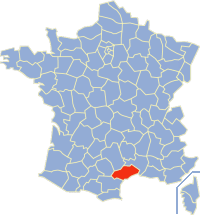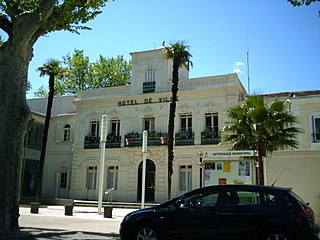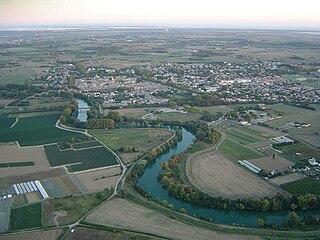Places
- Canton of Lunel, France
- Lunel, Hérault, France
- Lunel-Viel, Hérault, France
Lunel may refer to:

Hérault is a department of the region of Occitania, Southern France. Named after the Hérault River, its prefecture is Montpellier. It had a population of 1,175,623 in 2019.

The following is a list of the 342 communes of the Hérault department of France.
The following is a list of the 25 cantons of the Hérault department, in France, following the French canton reorganisation which came into effect in March 2015:
Saint-Félix may refer to:
Garrigues may refer to:

Lunel is a commune in the Hérault department in southern France. Lunel is located 21 km (13 mi) east of Montpellier and 28 km (17 mi) southwest of Nîmes (Gard). Lunel station has rail connections to Narbonne, Montpellier, Nîmes and Avignon.

The arrondissement of Montpellier is an arrondissement of France. It is part of the Hérault département. Its INSEE code is 343 and its capital city, and prefecture of the department, is Montpellier. It has 67 communes. Its population is 683,935 (2016), and its area is 1,004.8 km2 (388.0 sq mi).

The Vidourle is a 95.0 km (59.0 mi) river in southern France that flows into the Mediterranean Sea in Le Grau-du-Roi. Its source is in the Cévennes mountains, northwest of Saint-Hippolyte-du-Fort, at Saint-Roman-de-Codières. It flows generally southeast. At Gallargues-le-Montueux, it was crossed by the old Roman road Via Domitia with the now ruined Roman bridge Pont Ambroix.

The A9 autoroute is a motorway in Southern France.

The Pont Ambroix or Pont d'Ambrussum was a 1st-century BC Roman bridge in the south of France which was part of the Via Domitia. It crossed the Vidourle at Ambrussum, between today's Gallargues-le-Montueux in the Gard department and Villetelle in the Hérault department.
Hérault is a department in the southwest of France.

Marsillargues is a commune in the Hérault department in southern France.
Folquet de Lunel was a troubadour from Lunel in the Languedoc. He left behind nine recorded lyric poems, including five cansos, two partimens, and two sirventes. He also wrote one longer work, the Romans de mondana vida. Folquet's birth date can be known precisely because he tells us in his Romans, written in 1284, that he was forty years old at the time.
Saint-Félix-de-Lunel is a commune in the Aveyron department in southern France.

Lunel-Viel is a commune in the Hérault department in southern France. Lunel-Viel station has rail connections to Narbonne, Montpellier and Avignon.
Nationality words link to articles with information on the nation's poetry or literature.

The canton of Lunel is an administrative division of the Hérault department, southern France. Its borders were modified at the French canton reorganisation which came into effect in March 2015. Its seat is in Lunel.

The 9th constituency of Hérault is a French legislative constituency in the Hérault département.

Alfred Frank de Prades French painter working in Victorian England. An Animalier best known for his paintings of horses and military subjects, de Prades’ works follow very closely the tradition of George Stubbs (1724–1806) a style which popularized him among the noble British sporting set, who heavily patronized the artist from about 1850 until his death in 1885.